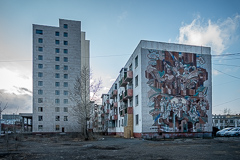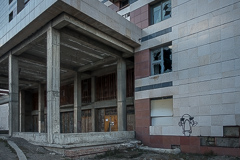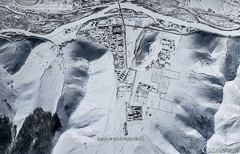Public Land, Private Interest

Partially Blocked Urban Squatter

Abandoned Entrance
At the talk, I showed pictures of some of our treasured national parks, and also pictures of places in Mongolia that probably deserve special protection as well. After the talk, I answered questions about geology, (with the help of a young Mongolian geologist) but also the different kinds of public land we have in the United States. There is public land in Mongolia, but it doesn't seem to be understood the same way that we understand it.
The end of the communist era brought the need for a new system of public and private property ownership. Where once the state was the owner of practically all land, independence and the accompanying market economy brought a need to resolve issues surrounding the distribution and occupation of Mongolia's real property. For many rural nomadic herders who didn't intend to own land, not much changed. They are nomads because keeping animals on the same dry plot of ground for weeks at a time, much less years, will destroy it for grazing. And what is good, passible, or even poor grazing land is often not much good for anything else. What had been public grazing land mostly remains public grazing land, even today. But those who lived in towns and cities would face real estate issues similar to ours, which require legal codes controlling the ownership, zoning, and transfer of real estate.
I've asked several people what happened to the vacant building on Chingis Avenue and all told a similar story. It was built on unoccupied land that the builders did not own, between and just to the south of existing Soviet-era apartments. Although there was something signed by a government official, there were many more officials who never signed off on the building. Once built, it placed apartments that had seen sunlight for decades into the shade, robbing them of the view of Bogd Khaan Uul, the mountain range to the south. A protest was launched, the new building forced to close. So far though, the view from the apartments is no better, and nobody I talked to knew whether there were plans to demolish the rogue building. For the time being, it is simply being scavenged.
Money pit to anxious parties concerned about losing their sizable investment, or eyesore and cause of the loss of the apartment dwellers' sunlight—for me that building is a faint sign of optimism, though I'd be more optimistic if it is actually leveled. Many times here construction simply proceeds regardless of land ownership, zoning, building permits, or other concerns because of a toxic mix of greed, a government weakened by corruption that causes those responsible for overseeing public land to ignore what is obvious to every other citizen, and what I can only describe as public apathy, though I've heard of criminal threats that occur when someone tries to prevent a desired real estate deal. (A physically-fit friend described being pursued by thugs after leaving a meeting at which he was asked to sell property that he didn't want to part with.) This one vacant structure is a dear piece of evidence that building illegally doesn't pay. Unfortunately, most of the evidence here is to the contrary.
A century before we created Yellowstone National Park, Mongolia set aside the land that is now Bogd Khan Strictly Protected Area as a nature preserve. Now, as it has for over a decade, construction creeps steadily up its sacred valleys. Because you can find traditional gers set up on practically any small patch of land in the city, I imagined that there must be a deficiency of laws to regulate squatting on unoccupied property, something that would explain the gers and the vacant building, as well as the systematic trashing of sacred land. But a friend here did his best to set me straight. Twenty-five years of independence has been time enough for Mongolians to have all the real estate laws they need. (As, you would think, do we after nearly two hundred and fifty.) He assured me that what I am describing is not a lack of either time or laws. It is a problem of the attraction of money to the government officials who make and enforce the laws.
Unfortunately, we speak the same language. With 501(c)(4) Social Welfare organizations and Super PACs, as well the crippling of agencies whose job it is to oversee them, and the tortured logic of corporate personhood overriding plain old person personhood, we have institutionalized the exchange of money for influence, something that is still called bribery in Mongolia. It is still illegal too, though seeming to read from our playbook, the parliament recently passed an amnesty that released 3000 prisoners. Among the crimes forgiven were corruption.
In the US, we face pressure from business, mining, and drilling interests to have their way with our public land, but fortunately we also have a very vigilant and strong public opposition. Throughout our west there are constant complaints about federal ownership and management of land, with the biggest opponents being those who would have the most influence over how the land would be divided up if given to states. For several years there was a spree of people driving bulldozers through Utah's desert so that they could then prove that land designated as wilderness was no longer wilderness. Thanks to the efforts of organizations such as Southern Utah Wilderness Alliance, who could have pointed to the fact that ordinary citizens don't drive bulldozers, that logic didn't prove persuasive to the courts.
Organizations like SUWA depend on a significant population who care deeply about public land and its protection, as well as a court system willing to pursue legal claims. Here, construction has continued without any signs of visible opposition except an occasional editorial in the newspaper.
Bogd Khaan Uul is one of Ulaanbaatar's four sacred mountains. Though strictly protected for centuries, it joins a list of places that must no longer seem very special to Mongolians.
In 2009 continued rampant construction and development in Bogd Khan Strictly Protected Area caused the World Bank to lose confidence in Mongolia's commitment to environmental protection. In 2012 Global Environment Facility, which administered the funding of a $6.7 million project for the Revitalization of Mongolia's Protected Areas through Effective Forest Management of Bogd Khan Uul canceled the project. There are quite a few Mongolians who are winning from the exploitation of protected land, but Mongolia is the loser.

